Fresh, Mechanical, and Thermal Properties of Cement Composites Containing Recycled Foam Concrete as Partial Replacement of Cement and Fine Aggregate
Abstract
:1. Introduction
2. Materials and Methods
2.1. Materials
2.2. Methods
- Initial setting time: EN 480-2:2008 Admixtures for concrete, mortar, and grout—Test methods—Part 2: Determination of setting time [60];
- Consistency: EN 1015-3:2000/A2:2007 Methods of test for mortar for masonry—part 3: determination of consistence of fresh mortar (by flow table) [59];
- Density of fresh mortar: EN 1015-6 Methods of test for mortar for masonry—part 6: Determination of bulk density of fresh mortar [61];
- Compressive strength: EN 196-1 Methods of testing cement—Part 1: Determination of strength [58];
- Density of hardened mortar: EN 1015-10 Methods of test for mortar for masonry—part 10: Determination of dry bulk density [62];
- Absorbability was tested on samples prepared for density test, cured in water for 28 days, weighted, and dried to constant mass;
- Microstructure observations: The examination was performed using an electron scanning microscope (JEOL JSM-7200F; JEOL company, Tokyo, Japan) equipped with an EDS analyzer;
- Thermal properties were assessed with ISOMET 2114 Portable Thermal Properties Analyzer (Applied Precision s.r.o., Bratislava, Slovakia). Samples used for these tests were cubic 10 × 10 × 10 cm. Determination of thermal properties using the ISOMET instrument is based on the ‘hot plate’ method and involves analysing changes in the surface temperature of the test sample in two phases. Firstly, while it is being heated at constant power, and secondly, while it is being cooled. Thermal conductivity (λ) and volume heat capacity (cρ) were recorded.
3. Results
3.1. Fresh Mix Properties
3.1.1. Consistency
3.1.2. Fresh Density
3.1.3. Initial Setting Time
3.2. Hardened Composites Properties
3.2.1. Density
3.2.2. Absorbability
3.2.3. Compressive Strength
3.2.4. Thermal Properties
3.2.5. Correlations of Mortars Properties
3.2.6. Microstructure
4. Discussion
5. Conclusions
- Waste from the production of foam concrete can be used in the preparation of mortars. When added in small quantities, it causes an acceptable deterioration in mechanical properties while improving thermal properties. This material can be used especially in the production of plasters and mortars.
- Replacing part of the sand with waste foam concrete improves the thermomechanical index, defined as the ratio between compressive strength and thermal conductivity coefficient. This shows the suitability of this material. Replacing part of the cement reduces the value of this index.
- There is no need to over-mill RFCD. The results of the density, absorbability, and compressive strength tests show that replacing the cement with RFCD with a maximum grain size of 0.063 mm and 0.125 mm in the same amount does not affect these values.
- The linear correlations of density—thermal conductivity coefficient and compressive strength—thermal conductivity coefficient are good for both the replacement of the cement part with RFCD and the sand part with RFCA.
Funding
Institutional Review Board Statement
Informed Consent Statement
Data Availability Statement
Conflicts of Interest
References
- 2022 Global Status Report for Buildings and Construction|UNEP—UN Environment Programme. Available online: https://www.unep.org/resources/publication/2022-global-status-report-buildings-and-construction (accessed on 12 October 2023).
- U.S. Geological Survey. Mineral Commodity Summaries 2022—Cement. Available online: https://pubs.usgs.gov/periodicals/mcs2022/mcs2022-cement.pdf (accessed on 9 November 2023).
- Lehne, J.; Preston, F. Making Concrete Change: Innovation in Low-Carbon Cement and Concret; Chatham House—International Affairs Think Tank: London, UK, 2018. [Google Scholar]
- Lehner, P.; Horňáková, M.; Pizoń, J.; Gołaszewski, J. Effect of Chemical Admixtures on Mechanical and Degradation Properties of Metallurgical Sludge Waste Concrete. Materials 2022, 15, 8287. [Google Scholar] [CrossRef] [PubMed]
- Alwaeli, M.; Gołaszewski, J.; Niesler, M.; Pizoń, J.; Gołaszewska, M. Recycle Option for Metallurgical Sludge Waste as a Partial Replacement for Natural Sand in Mortars Containing CSA Cement to Save the Environment and Natural Resources. J. Hazard. Mater. 2020, 398, 123101. [Google Scholar] [CrossRef] [PubMed]
- Pizoń, J.; Gołaszewski, J.; Alwaeli, M.; Szwan, P. Properties of Concrete with Recycled Concrete Aggregate Containing Metallurgical Sludge Waste. Materials 2020, 13, 1448. [Google Scholar] [CrossRef] [PubMed]
- Poranek, N.; Łaźniewska-Piekarczyk, B.; Czajkowski, A.; Pikoń, K. Circular Economy for Municipal Solid Waste Incineration Bottom Ash (MSWIBA) Management in Mortars with CSA and CEM I, MSWIBA Glassy Phase, and DTG. Energies 2021, 15, 135. [Google Scholar] [CrossRef]
- Poranek, N.; Łaźniewska-Piekarczyk, B.; Lombardi, L.; Czajkowski, A.; Bogacka, M.; Pikoń, K. Green Deal and Circular Economy of Bottom Ash Waste Management in Building Industry—Alkali (NaOH) Pre-Treatment. Materials 2022, 15, 3487. [Google Scholar] [CrossRef]
- Zhao, T.; Lv, Y.; Chen, J.; Song, P.; Sun, M.; Zhang, X.; Huang, L. Effect of Glass Fiber-Reinforced Plastic Waste on the Mechanical Properties of Concrete and Evaluation of Its Feasibility for Reuse in Concrete Applications. Materials 2023, 16, 6772. [Google Scholar] [CrossRef]
- Utilizing, A.; Chen, Z.; Hua, J.; Wang, N.; Kamal Askar, M.; S Al-Kamaki, Y.S.; Hassan, A. Utilizing Polyethylene Terephthalate PET in Concrete: A Review. Polymers 2023, 15, 3320. [Google Scholar] [CrossRef]
- Helmy, S.H.; Tahwia, A.M.; Mahdy, M.G.; Abd Elrahman, M.; Abed, M.A.; Youssf, O. The Use of Recycled Tire Rubber, Crushed Glass, and Crushed Clay Brick in Lightweight Concrete Production: A Review. Sustainability 2023, 15, 10060. [Google Scholar] [CrossRef]
- Mahat, M.; Acharya, M.; Acharya, M.; Mashal, M. Use of Waste Tires as Transverse Reinforcement and External Confinement in Concrete Columns Subjected to Axial Loads. Sustainability 2023, 15, 11620. [Google Scholar] [CrossRef]
- Green, E.; Jaya, P.; Sheikh Hassani, M.; Matos, J.C.; Zhang, Y.; Teixeira, E.R. Green Concrete with Glass Powder—A Literature Review. Sustainability 2023, 15, 14864. [Google Scholar] [CrossRef]
- Epure, C.; Munteanu, C.; Istrate, B.; Harja, M.; Buium, F. Applications of Recycled and Crushed Glass (RCG) as a Substitute for Natural Materials in Various Fields—A Review. Materials 2023, 16, 5957. [Google Scholar] [CrossRef] [PubMed]
- Cerchione, R.; Colangelo, F.; Farina, I.; Ghisellini, P.; Passaro, R.; Ulgiati, S. Life Cycle Assessment of Concrete Production within a Circular Economy Perspective. Sustainability 2023, 15, 11469. [Google Scholar] [CrossRef]
- Hubert, J.; Zhao, Z.; Michel, F.; Courard, L. Effect of Crushing Method on the Properties of Produced Recycled Concrete Aggregates. Buildings 2023, 13, 2217. [Google Scholar] [CrossRef]
- Hamada, H.M.; Shi, J.; Abed, F.; Al Jawahery, M.S.; Majdi, A.; Yousif, S.T. Recycling Solid Waste to Produce Eco-Friendly Ultra-High Performance Concrete: A Review of Durability, Microstructure and Environment Characteristics. Sci. Total Environ. 2023, 876, 162804. [Google Scholar] [CrossRef] [PubMed]
- Chaudhary, N.; Mohanty, I.; Saha, P.; Kumari, R.; Kumar Pandey, A. Performance of Resource Saving Agro-Industrial Wastes and Their Utilization in Lightweight Concrete—A Review. Mater. Today Proc. 2023; in press. [Google Scholar] [CrossRef]
- Jahami, A.; Issa, C.A. Exploring the Use of Mixed Waste Materials (MWM) in Concrete for Sustainable Construction: A Review. Constr. Build. Mater. 2023, 398, 132476. [Google Scholar] [CrossRef]
- Raj, A.; Sathyan, D.; Mini, K.M. Physical and Functional Characteristics of Foam Concrete: A Review. Constr. Build. Mater. 2019, 221, 787–799. [Google Scholar] [CrossRef]
- Xiao, J.; Hao, L.; Cao, W.; Ye, T. Influence of Recycled Powder Derived from Waste Concrete on Mechanical and Thermal Properties of Foam Concrete. J. Build. Eng. 2022, 61, 105203. [Google Scholar] [CrossRef]
- Gołaszewski, J.; Klemczak, B.; Smolana, A.; Gołaszewska, M.; Cygan, G.; Mankel, C.; Peralta, I.; Röser, F.; Koenders, E.A.B. Effect of Foaming Agent, Binder and Density on the Compressive Strength and Thermal Conductivity of Ultra-Light Foam Concrete. Buildings 2022, 12, 1176. [Google Scholar] [CrossRef]
- Othuman, M.A.; Wang, Y.C. Elevated-Temperature Thermal Properties of Lightweight Foamed Concrete. Constr. Build. Mater. 2011, 25, 705–716. [Google Scholar] [CrossRef]
- Zhao, W.; Su, Q.; Wang, W.; Niu, L.; Liu, T. Experimental Study on the Effect of Water on the Properties of Cast in Situ Foamed Concrete. Adv. Mater. Sci. Eng. 2018, 2018, 7130465. [Google Scholar] [CrossRef]
- Jones, M.R.; McCarthy, A. Behaviour and Assessment of Foamed Concrete for Construction Applications. In Use of Foamed Concrete in Construction; Thomas Telford Publishing: London, UK, 2015; pp. 61–88. [Google Scholar]
- Shang, X.; Qu, N.; Li, J. Development and Functional Characteristics of Novel Foam Concrete. Constr. Build. Mater. 2022, 324, 126666. [Google Scholar] [CrossRef]
- Mydin, M.A.O.; Wang, Y.C. Mechanical Properties of Foamed Concrete Exposed to High Temperatures. Constr. Build. Mater. 2012, 26, 638–654. [Google Scholar] [CrossRef]
- Jitchaiyaphum, K.; Sinsiri, T.; Chindaprasirt, P. Cellular Lightweight Concrete Containing Pozzolan Materials. Procedia Eng. 2011, 14, 1157–1164. [Google Scholar] [CrossRef]
- Tan, X.; Chen, W.; Wang, J.; Yang, D.; Qi, X.; Ma, Y.; Wang, X.; Ma, S.; Li, C. Influence of High Temperature on the Residual Physical and Mechanical Properties of Foamed Concrete. Constr. Build. Mater. 2017, 135, 203–211. [Google Scholar] [CrossRef]
- Irawan, T.; Saloma; Idris, Y. Mechanical Properties of Foamed Concrete with Additional Pineapple Fiber and Polypropylene Fiber. J. Phys. Conf. Ser. 2019, 1198, 082018. [Google Scholar] [CrossRef]
- Kozłowski, M.; Kadela, M. Mechanical Characterization of Lightweight Foamed Concrete. Adv. Mater. Sci. Eng. 2018, 2018, 6801258. [Google Scholar] [CrossRef]
- Bakhshi, M.; Dalalbashi, A.; Soheili, H. Energy Dissipation Capacity of an Optimized Structural Lightweight Perlite Concrete. Constr. Build. Mater. 2023, 389, 131765. [Google Scholar] [CrossRef]
- Topçu, I.B.; Işikdaǧ, B. Effect of Expanded Perlite Aggregate on the Properties of Lightweight Concrete. J. Mater. Process. Technol. 2008, 204, 34–38. [Google Scholar] [CrossRef]
- Al-Tarbi, S.M.; Baghabra Al-Amoudi, O.S.; Al-Osta, M.A.; Al-Awsh, W.A.; Shameem, M.; Sharif Zami, M. Development of Energy-Efficient Hollow Concrete Blocks Using Perlite, Vermiculite, Volcanic Scoria, and Expanded Polystyrene. Constr. Build. Mater. 2023, 371, 130723. [Google Scholar] [CrossRef]
- Schackow, A.; Effting, C.; Folgueras, M.V.; Güths, S.; Mendes, G.A. Mechanical and Thermal Properties of Lightweight Concretes with Vermiculite and EPS Using Air-Entraining Agent. Constr. Build. Mater. 2014, 57, 190–197. [Google Scholar] [CrossRef]
- Ahmadi, S.F.; Reisi, M.; Sajadi, S.M. Comparing Properties of Foamed Concrete and Lightweight Expanded Clay Aggregate Concrete at the Same Densities. Case Stud. Constr. Mater. 2023, 19, e02539. [Google Scholar] [CrossRef]
- Bideci, A.; Bideci, Ö.S.; Ashour, A. Mechanical and Thermal Properties of Lightweight Concrete Produced with Polyester-Coated Pumice Aggregate. Constr. Build. Mater. 2023, 394, 132204. [Google Scholar] [CrossRef]
- Muhtar. Performance-Based Experimental Study into Quality Zones of Lightweight Concrete Using Pumice Aggregates. Case Stud. Constr. Mater. 2023, 18, e01960. [Google Scholar] [CrossRef]
- Graziano, S.F.; Zanelli, C.; Molinari, C.; de Gennaro, B.; Giovinco, G.; Correggia, C.; Cappelletti, P.; Dondi, M. Use of Screen Glass and Polishing Sludge in Waste-Based Expanded Aggregates for Resource-Saving Lightweight Concrete. J. Clean. Prod. 2022, 332, 130089. [Google Scholar] [CrossRef]
- Liang, Y.; Wang, Q.; Gan, W.; Liao, J.; Lai, M.; Ho, J. A 14-Year Study on Ceramic Waste Slag-Based Lightweight Aggregate Concrete. Constr. Build. Mater. 2022, 330, 127152. [Google Scholar] [CrossRef]
- Muthusamy, K.; Budiea AM, A.; Zaidan AL, F.; Rasid, M.H.; Hazimmah, D.S. Properties of Concrete Containing Foamed Concrete Block Waste as Fine Aggregate Replacement. IOP Conf. Ser. Mater. Sci. Eng. 2017, 271, 012084. [Google Scholar] [CrossRef]
- Domagała, L. The Effect of Lightweight Aggregate Water Absorption on the Reduction of Water-Cement Ratio in Fresh Concrete. Procedia Eng. 2015, 108, 206–213. [Google Scholar] [CrossRef]
- Castro, J.; Keiser, L.; Golias, M.; Weiss, J. Absorption and Desorption Properties of Fine Lightweight Aggregate for Application to Internally Cured Concrete Mixtures. Cem. Concr. Compos. 2011, 33, 1001–1008. [Google Scholar] [CrossRef]
- Kim, Y.H.; Park, C.B.; Choi, B.I.; Shin, T.Y.; Jun, Y.; Kim, J.H. Quantitative Measurement of Water Absorption of Coarse Lightweight Aggregates in Freshly-Mixed Concrete. Int. J. Concr. Struct. Mater. 2020, 14, 34. [Google Scholar] [CrossRef]
- Petrella, A.; Di Mundo, R.; Notarnicola, M. Recycled Expanded Polystyrene as Lightweight Aggregate for Environmentally Sustainable Cement Conglomerates. Materials 2020, 13, 988. [Google Scholar] [CrossRef] [PubMed]
- Ben Fraj, A.; Kismi, M.; Mounanga, P. Valorization of Coarse Rigid Polyurethane Foam Waste in Lightweight Aggregate Concrete. Constr. Build. Mater. 2010, 24, 1069–1077. [Google Scholar] [CrossRef]
- Wang, J.; Zheng, K.; Cui, N.; Cheng, X.; Ren, K.; Hou, P.; Feng, L.; Zhou, Z.; Xie, N. Green and Durable Lightweight Aggregate Concrete: The Role of Waste and Recycled Materials. Materials 2020, 13, 3041. [Google Scholar] [CrossRef]
- Borhan, T.M. Effect of Using Recycled Lightweight Aggregate on the Properties of Concrete. J. Univ. Babylon 2015, 23, 453–464. [Google Scholar]
- Lalrinmawii, E.; Sahu, S.; Sarkar, P.; Davis, R. Feasible Use of Recycled Foam Concrete in Cement Mortar. IOP Conf. Ser. Mater. Sci. Eng. 2020, 936, 012011. [Google Scholar] [CrossRef]
- Gyurkó, Z.; Jankus, B.; Fenyvesi, O.; Nemes, R. Sustainable Applications for Utilization the Construction Waste of Aerated Concrete. J. Clean Prod. 2019, 230, 430–444. [Google Scholar] [CrossRef]
- Fenyvesi, O.; Jankus, B. Opportunities in Recycling AAC Waste as Aggregate for Lightweight Concrete. Epa. J. Silic. Based Compos. Mater. 2015, 67, 66–70. [Google Scholar] [CrossRef]
- Land, G.; Stephan, D. The Effect of Synthesis Conditions on the Efficiency of C-S-H Seeds to Accelerate Cement Hydration. Cem. Concr. Compos. 2018, 87, 73–78. [Google Scholar] [CrossRef]
- Liu, M.; Hu, R.; Zhang, Y.; Wang, C.; Ma, Z. Effect of Ground Concrete Waste as Green Binder on the Micro-Macro Properties of Eco-Friendly Metakaolin-Based Geopolymer Mortar. J. Build. Eng. 2023, 68, 106191. [Google Scholar] [CrossRef]
- Bouarroudj, M.E.K.; Rémond, S.; Bulteel, D.; Potier, G.; Michel, F.; Zhao, Z.; Courard, L. Use of Grinded Hardened Cement Pastes as Mineral Addition for Mortars. J. Build. Eng. 2021, 34, 101863. [Google Scholar] [CrossRef]
- Ma, X.; Wang, Z. Effect of Ground Waste Concrete Powder on Cement Properties. Adv. Mater. Sci. Eng. 2013, 2013, 918294. [Google Scholar] [CrossRef]
- Recycling Old, A.; Li, L.; Zhang, S.; Li, X.; Xiao, J.; Zhu Xie, H.; Gu Li, L.; Liu, F.; Kwok Hung Kwan, A. Recycling Old Concrete as Waste Concrete Powder for Use in Pervious Concrete: Effects on Permeability, Strength and Eco-Friendliness. Buildings 2022, 12, 2172. [Google Scholar] [CrossRef]
- EN 196-3; Methods of Testing Cement—Part 3: Determination of Setting Times and Soundness. European Committee For Standardization: Brussels, Belgium, 2016.
- EN 196-1; Methods of Testing Cement—Part 1: Determination of Strength. European Committee For Standardization: Brussels, Belgium, 2018.
- EN 1015-3:2000/A2:2007; Methods of Test for Mortar for Masonry—Part 3: Determination of Consistence of Fresh Mortar (by Flow Table). European Committee For Standardization: Brussels, Belgium, 2007.
- EN 480-2; Admixtures for Concrete, Mortar, and Grout—Test Methods—Part 2: Determination of Setting Time. European Committee For Standardization: Brussels, Belgium, 2007.
- EN 1015-6:1999/A1:2007; Methods of Test for Mortar for Masonry—Part 6: Determination of Bulk Density of Fresh Mortar. European Committee For Standardization: Brussels, Belgium, 2007.
- EN 1015-10:2000/A1:2007; Methods of Test for Mortar for Masonry—Part 10: Determination of Dry Bulk Density. European Committee For Standardization: Brussels, Belgium, 2007.
- Pizon, J.; Lazniewska-Piekarczyk, B. Comparison of Efficiency of Accelerating Admixtures for Concrete Using Multiple-Criteria Decision Analysis (MCDA). IOP Conf. Ser. Mater. Sci. Eng. 2019, 471, 032043. [Google Scholar] [CrossRef]
- Nowak, J.; Jaskulski, R.; Kubissa, W.; Matusiak, B.; Banach, M. On the Need for a Paradigm Change in the Valuation of Concrete with Waste Materials Based on the Example of Concrete with Crumb Rubber. Sustainability 2023, 15, 3928. [Google Scholar] [CrossRef]
- Ding, Y.; She, A.; Yao, W. Investigation of Water Absorption Behavior of Recycled Aggregates and Its Effect on Concrete Strength. Materials 2023, 16, 4505. [Google Scholar] [CrossRef] [PubMed]
- García-González, J.; Rodríguez-Robles, D.; Juan-Valdés, A.; Pozo, J.M.M.d.; Guerra-Romero, M.I. Pre-Saturation Technique of the Recycled Aggregates: Solution to the Water Absorption Drawback in the Recycled Concrete Manufacture. Materials 2014, 7, 6224–6236. [Google Scholar] [CrossRef] [PubMed]
- Domagała, L.; Bryła, E.; Oh, J.-E.; Yoon, S.-Y. The Properties of Lightweight Aggregates Pre-Coated with Cement Pastes and Their Suitability for Concrete. Materials 2021, 14, 6417. [Google Scholar] [CrossRef]
- Lo, T.Y.; Cui, H.Z. Effect of Porous Lightweight Aggregate on Strength of Concrete. Mater. Lett. 2004, 58, 916–919. [Google Scholar] [CrossRef]
- Łaźniewska-Piekarczyk, B. The Influence of Superplasticizer and Shrinkage Reducing Admixture Type on Air-Content and Related Properties of HPSCC. MATEC Web. Conf. 2020, 322, 01040. [Google Scholar] [CrossRef]
- Wang, B.; Yao, W.; Stephan, D. Preparation of Calcium Silicate Hydrate Seeds by Means of Mechanochemical Method and Its Effect on the Early Hydration of Cement. Adv. Mech. Eng. 2019, 11. [Google Scholar] [CrossRef]
- Wichmann, I.; Stephan, D. Mechanical and Physical Properties of Concrete Made of Alkali-Activated Lightweight Aggregates from Construction Demolition Waste. Mater Today Proc. 2023; in press. [Google Scholar] [CrossRef]
- Zou, D.; Que, Z.; Cui, W.; Wang, X.; Guo, Y.; Zhang, S. Feasibility of Recycling Autoclaved Aerated Concrete Waste for Partial Sand Replacement in Mortar. J. Build. Eng. 2022, 52, 104481. [Google Scholar] [CrossRef]


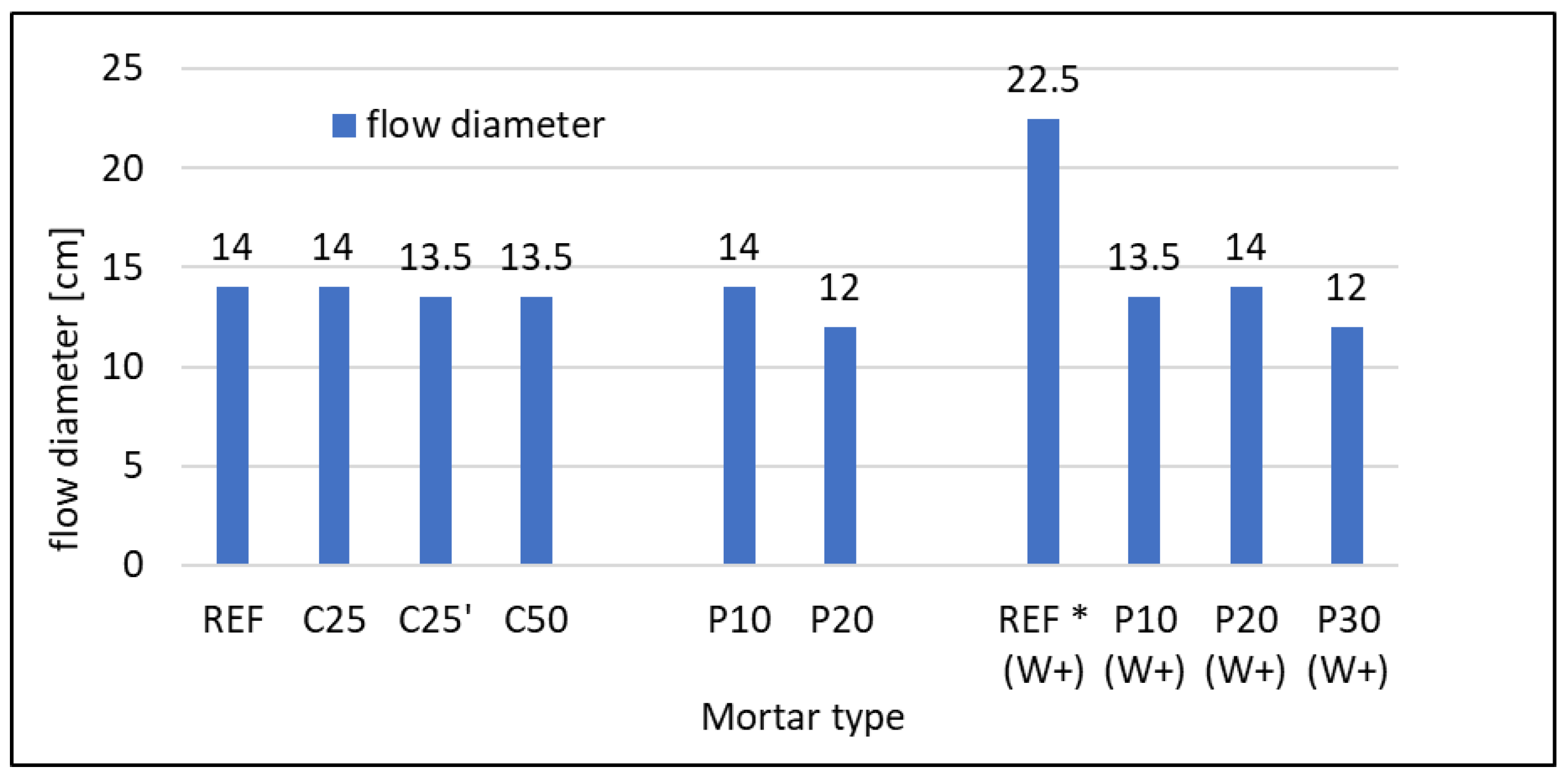
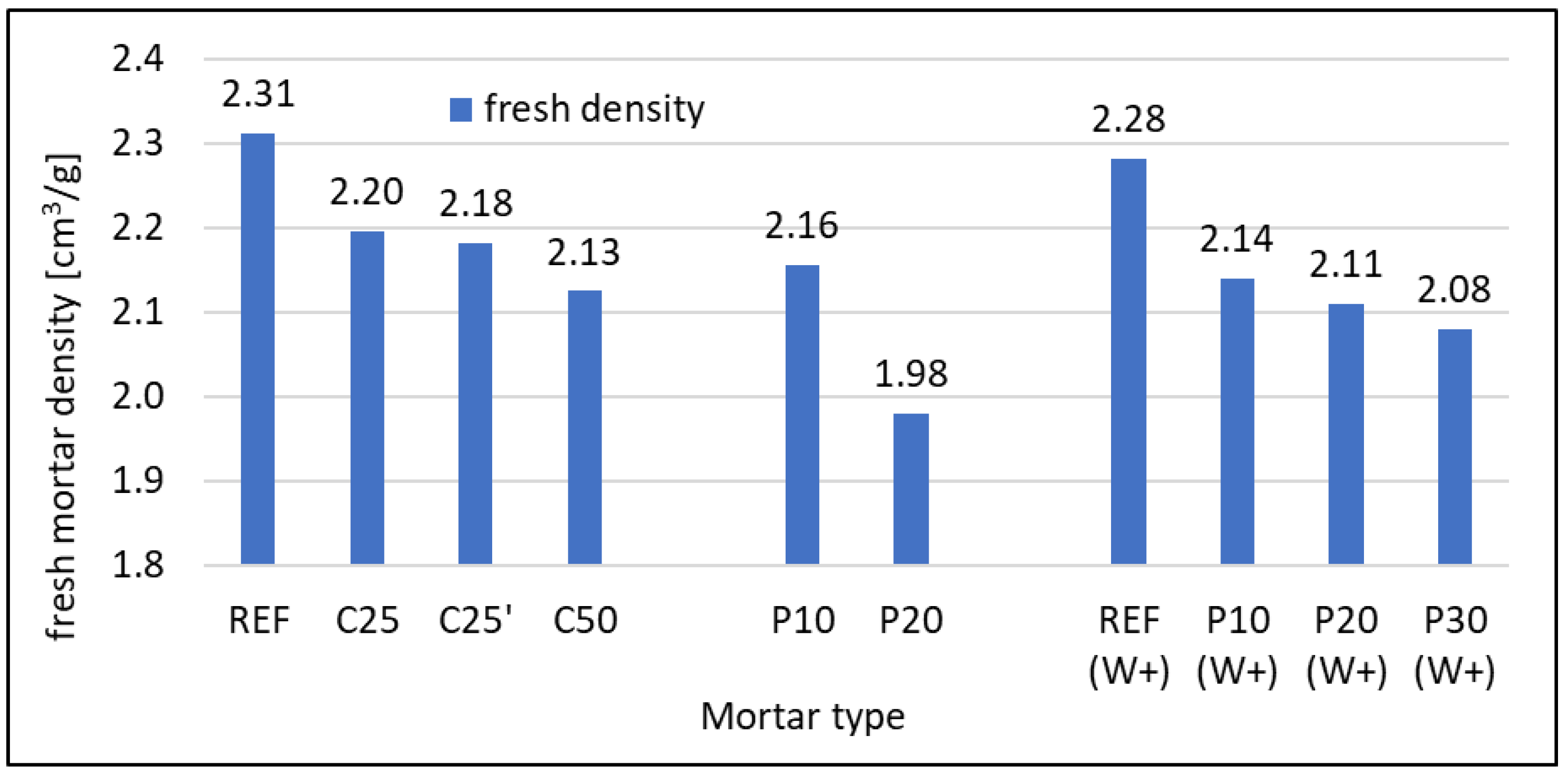
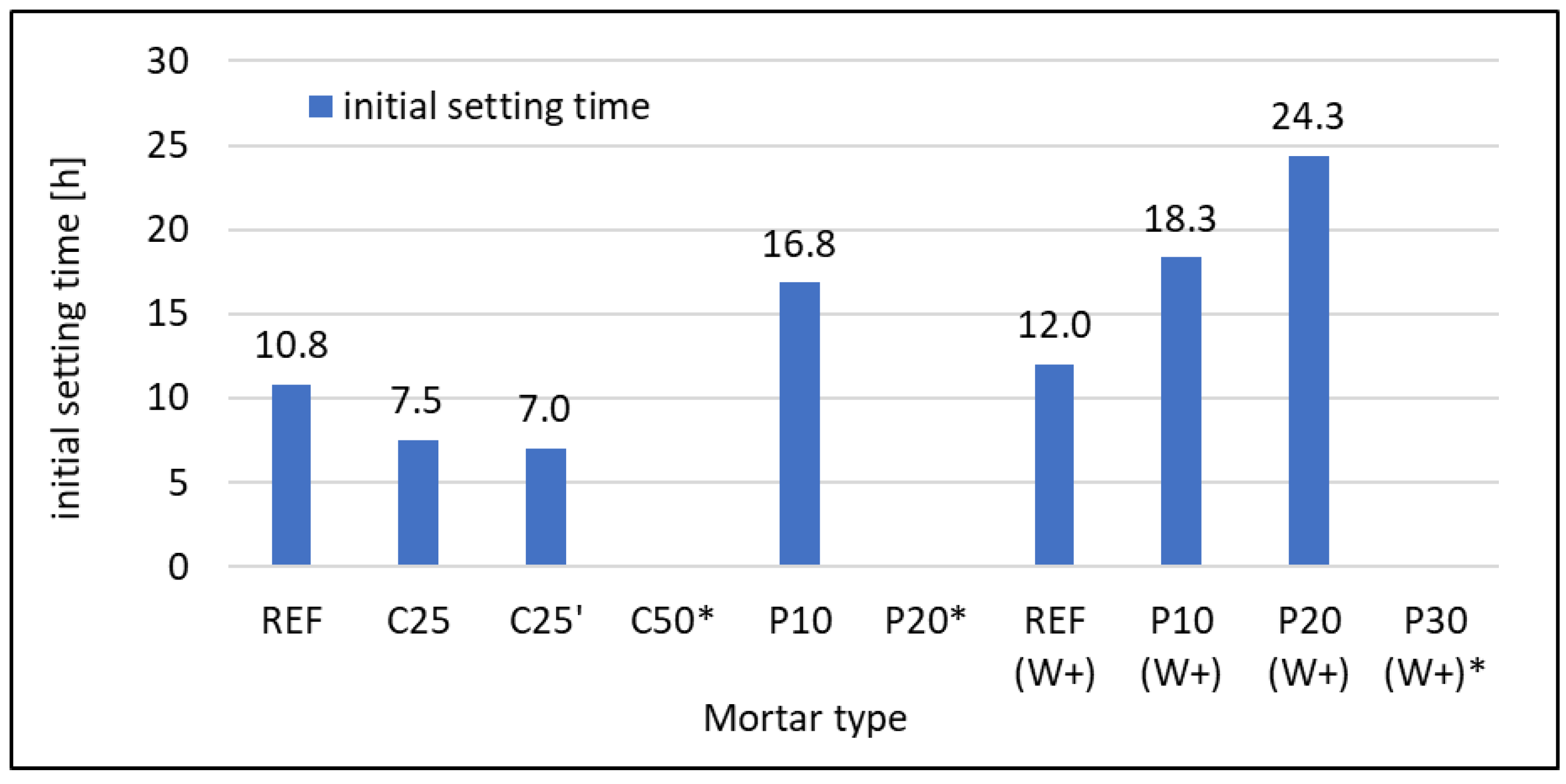
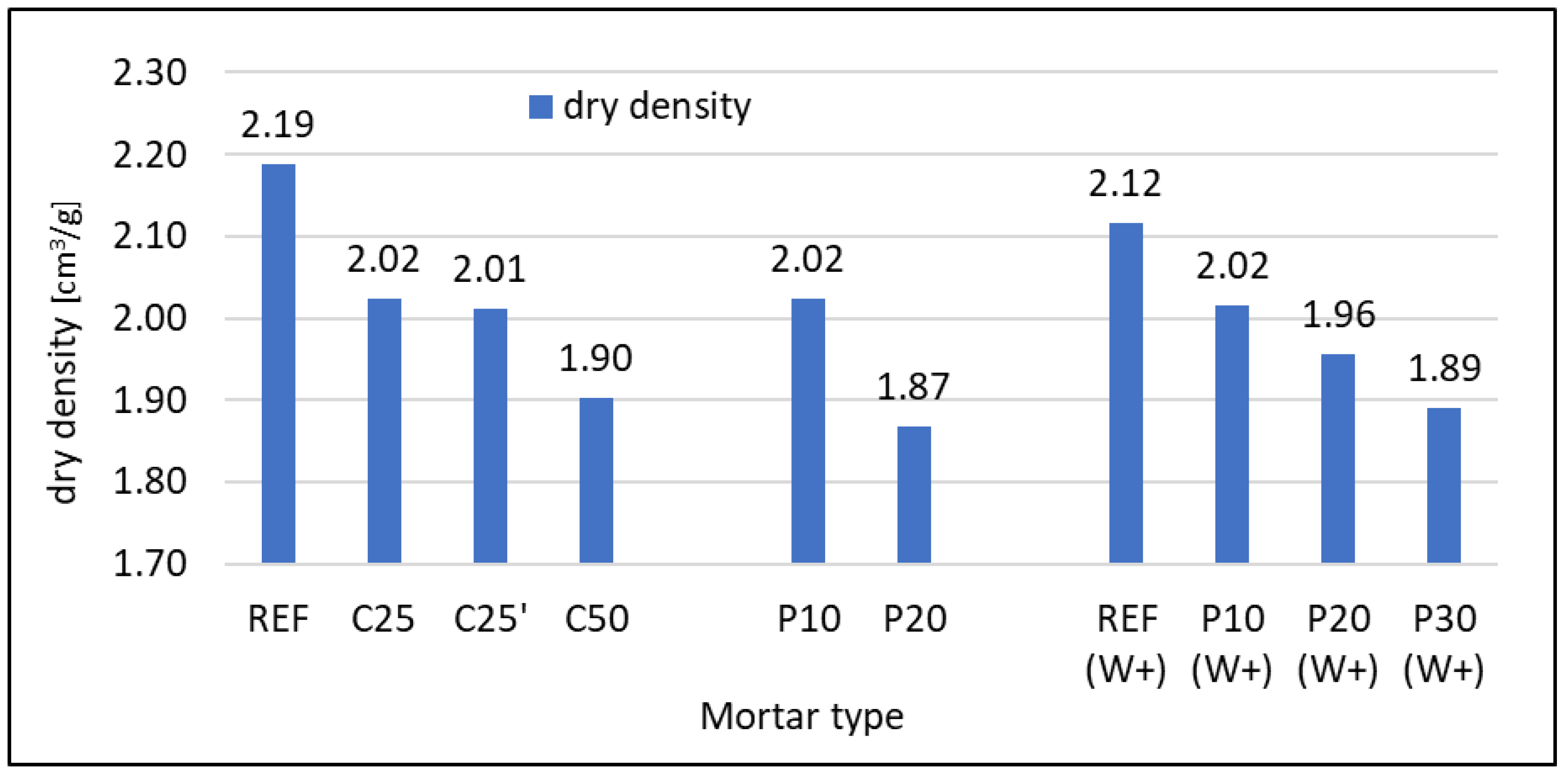
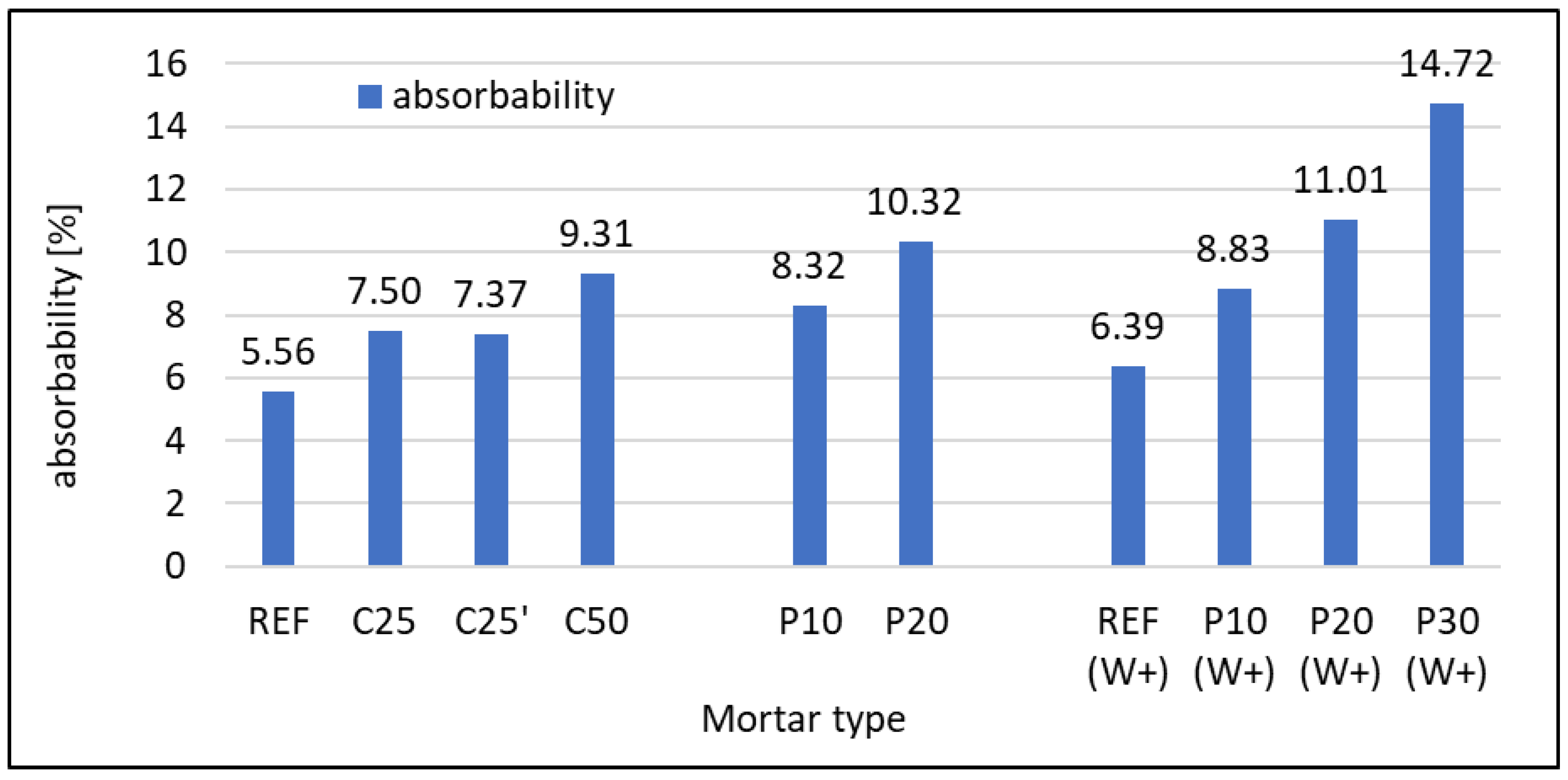
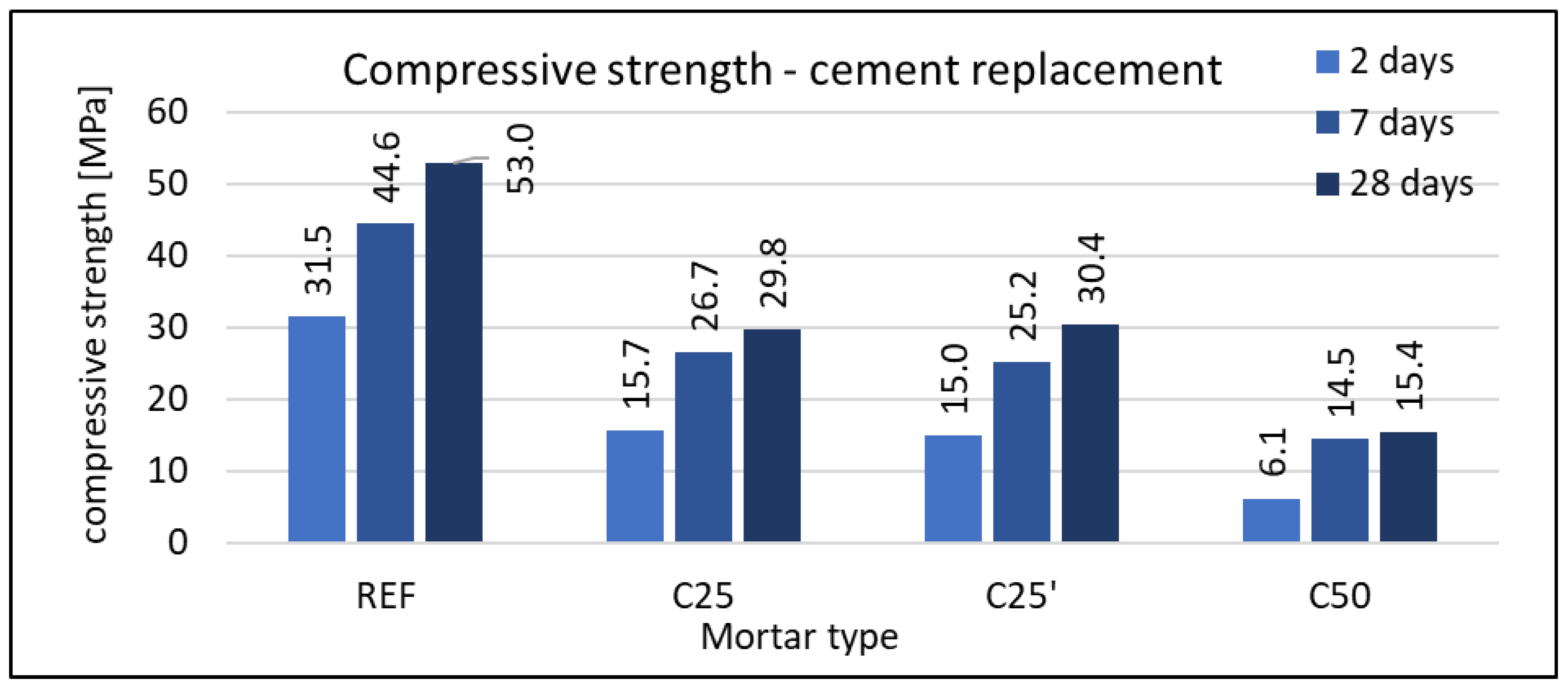

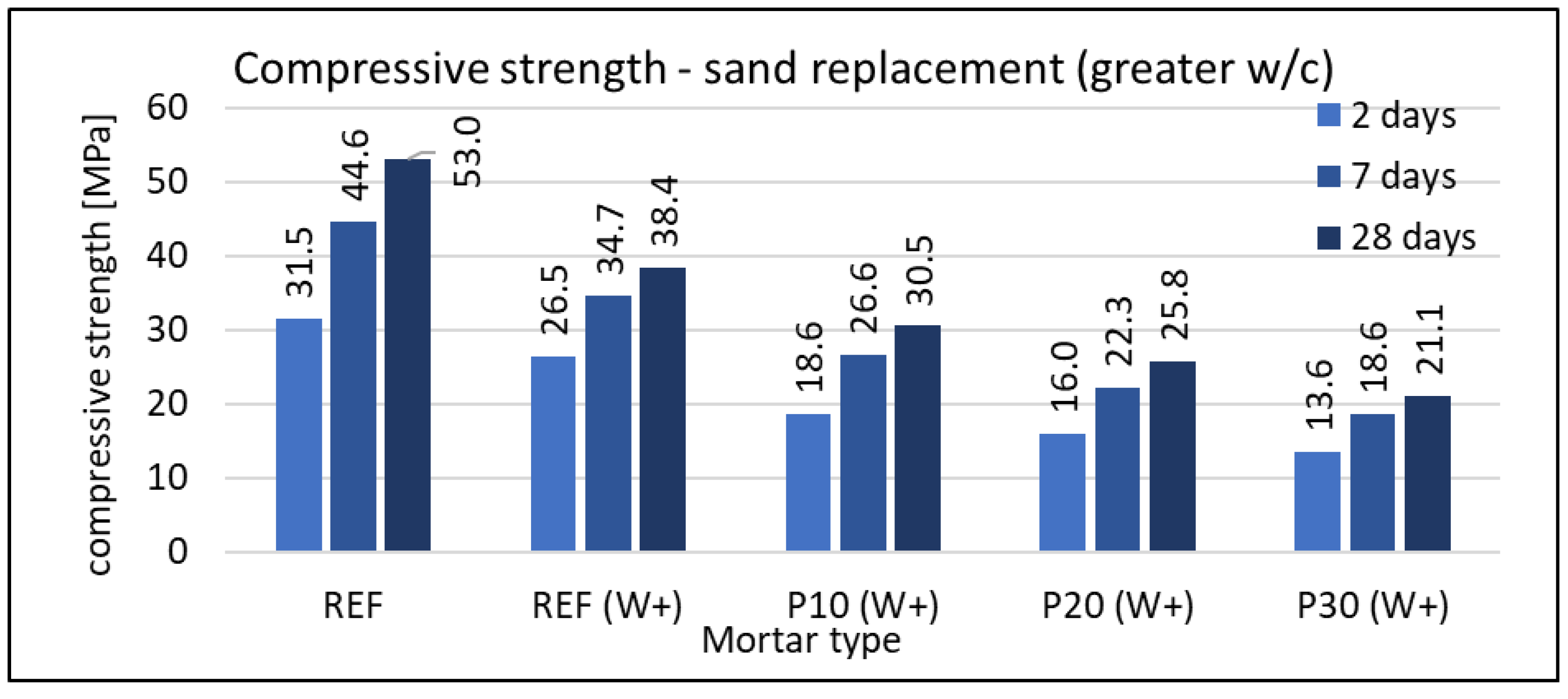



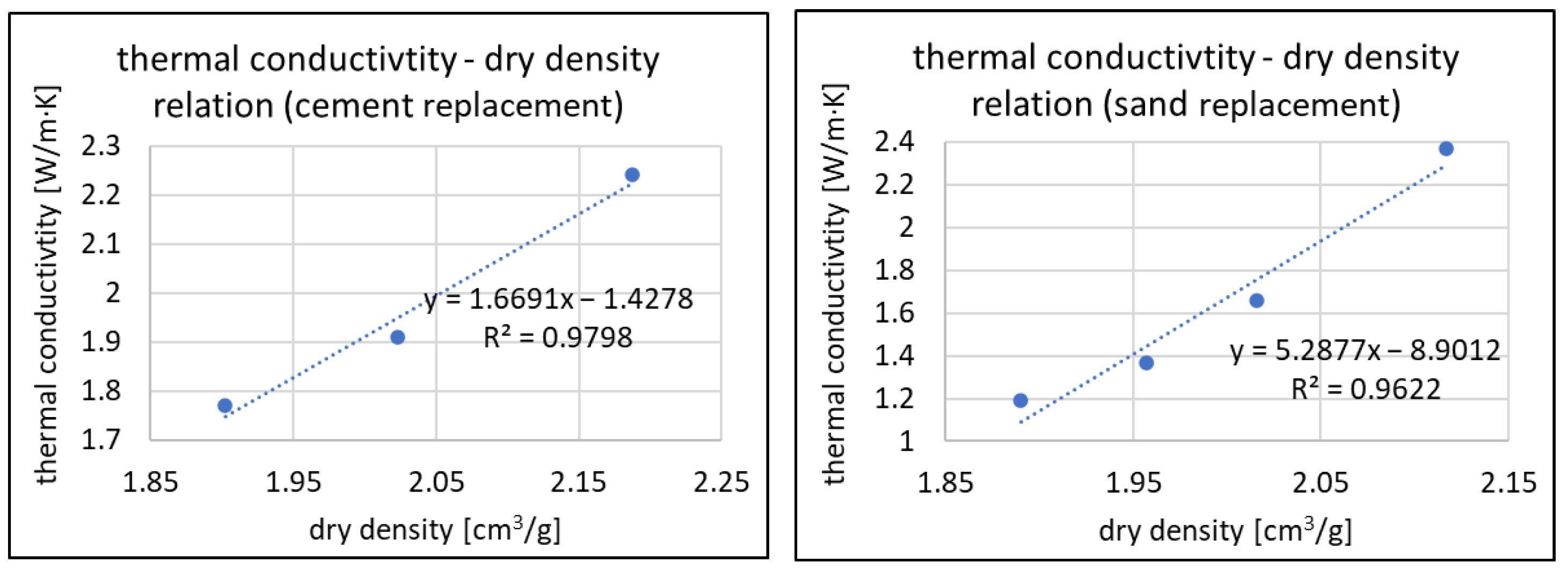
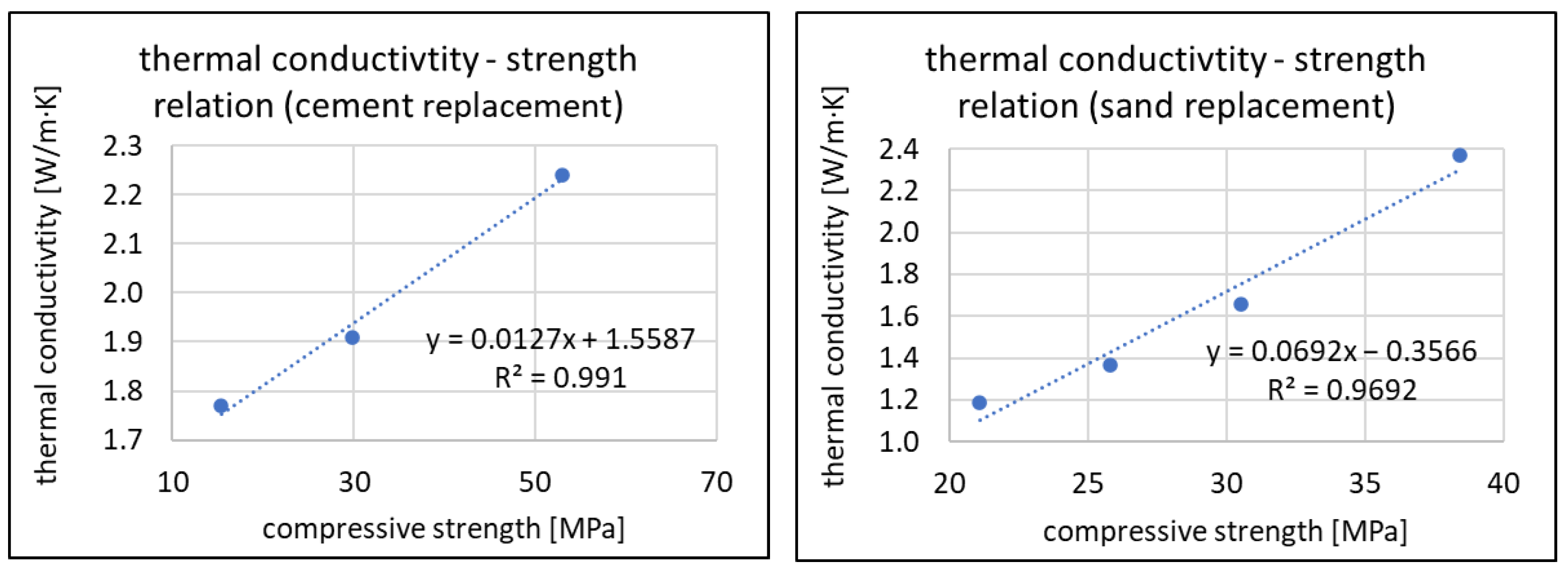
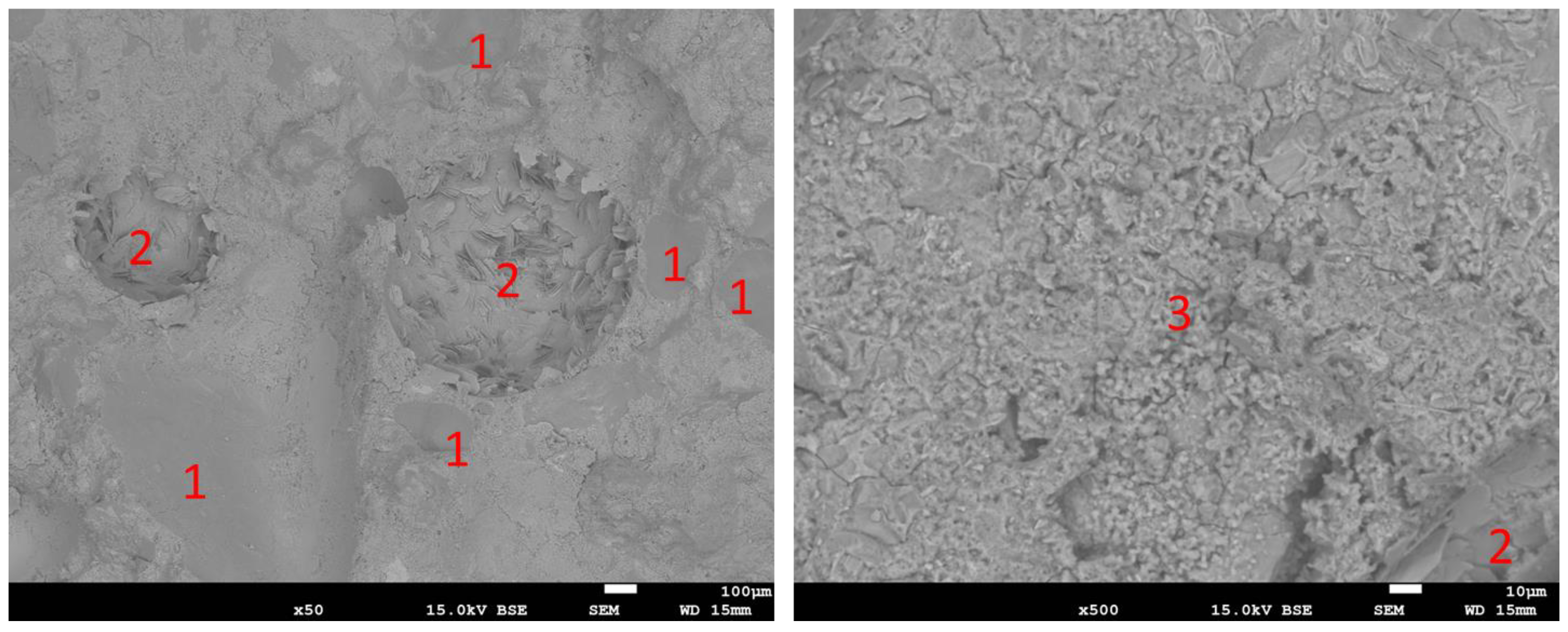

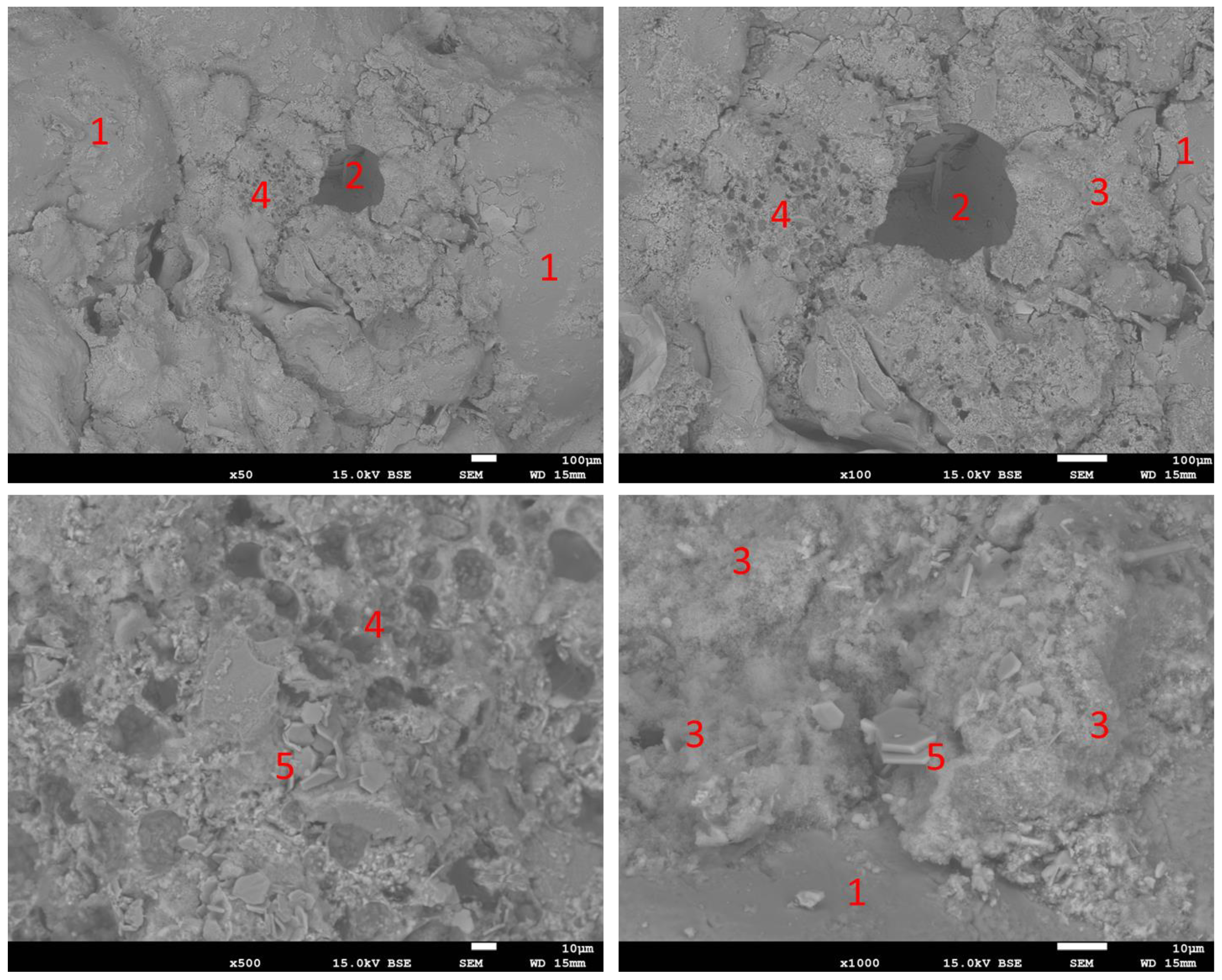
| Symbol | Cement | NS | RFC (Max Grain (mm)) | Water | SP | Water | SP | ||
|---|---|---|---|---|---|---|---|---|---|
| 0.063 | 0.125 | 4 | For Initial Setting Time Tests 1 | For Consistency Tests and Forming of Samples 2 | |||||
| (g) | (g) | (g) | (g) | (g) | (g) | (g) | (g) | (g) | |
| REF | 450 | 1350 | 225 | 0.91 | 225 | 0.35 | |||
| C25 | 337.5 | 1350 | 112.5 | 225 | 4.50 | 225 | 2.9 | ||
| C25′ | 337.5 | 1350 | 112.5 | 225 | 4.65 | 225 | 3.0 | ||
| C50 | 225 | 1350 | 225 | X 3 | 225 | 12.0 | |||
| P10 | 450 | 1215 | 135 | 225 | 18.0 | 225 | 5.55 | ||
| P20 | 450 | 1080 | 270 | X 3 | 225 | 22.5 | |||
| REF (W+) | 450 | 1350 | 225 | 0 4 | 225 | 0 5 | |||
| P10 (W+) | 450 | 1215 | 135 | 225 | 8.5 | 225 | 3.15 | ||
| P20 (W+) | 450 | 1080 | 270 | 225 | 15.2 | 225 | 8.15 | ||
| P30 (W+) | 450 | 945 | 405 | X 3 | 225 | 22.5 | |||
| Bulk Density (Loose) | Fractions (mm) | |||||||
|---|---|---|---|---|---|---|---|---|
| 0.0–0.063 | 0.063–0.125 | 0.125–0.25 | 0.25–0.5 | 0.5–1.0 | 1.0–2.0 | 2.0–4.0 | ||
| (g/dm3) | (%) | |||||||
| NS | 1627 | 0.5 | 1.4 | 9.7 | 41.1 | 43.6 | 3.7 | |
| RFCD (max 0.063 mm) | 550 | 100 | ||||||
| RFCD (max 0.125 mm) | 480 | 45 | 55 | |||||
| RFCA (max 4 mm) | 412 | 6.1 | 8.3 | 12.4 | 17.9 | 27.5 | 22.3 | 5.5 |
| Reference | Aggregate Used | Replacement Level | Compressive Strength (MPa) | Thermal Conductivity Coefficient (W/mK) | Thermomechanical Index Acc. to [64] |
|---|---|---|---|---|---|
| [48] | Crushed cellular concrete | 100% natural aggregate | 33.2 | 2.07 | 16.04 |
| 20% recycled coarse aggregate | 22.4 | 1.96 | 11.43 | ||
| 40% recycled coarse aggregate | 12.33 | 1.74 | 7.09 | ||
| 60% recycled coarse aggregate | 13.47 | 1.63 | 8.26 | ||
| 100% recycled coarse aggregate | 9.05 | 1.32 | 6.86 | ||
| 100% recycled coarse aggregate; 100% recycled fine aggregate | 8.40 | 1.18 | 7.12 | ||
| [49] | AAC | 100% natural sand | 24 | n/d | |
| 15% crushed AAC as fine aggregate | 20 | ||||
| 30% crushed AAC as fine aggregate | 12 | ||||
| CLC | 100% natural sand | 24 | |||
| 15% crushed CLC as fine aggregate | 19 | ||||
| 30% crushed CLC as fine aggregate | 9 | ||||
| [51] | ACC | 100% recycled aggregate * | 12–16 | 0.39–0.45 | 30.77–35.56 |
| 100% recycled aggregate * | 6–9 | 0.28–0.36 | 21.43–25.00 | ||
| 100% recycled aggregate * | 2.5 | 0.28–0.36 | 8.93–6.94 | ||
| [72] | ACC | 100% natural aggregate | 33.8 | n/d | |
| 10% recycled AAC 0.15–4.75 mm | 33.8 | ||||
| 20% recycled AAC 0.15–4.75 mm | 32.6 | ||||
| 50% recycled AAC 0.15–4.75 mm | 26.9 | ||||
| 10% recycled AAC 0.15–0.3 mm | 35.8 | ||||
| 20% recycled AAC 0.15–0.3 mm | 38.1 | ||||
| 50% recycled AAC 0.15–0.3 mm | 37.2 | ||||
| 10% recycled AAC 0.3–4.75 mm | 33.2 | ||||
| 20% recycled AAC 0.3–4.75 mm | 31.9 | ||||
| 50% recycled AAC 0.3–4.75 mm | 25.7 | ||||
| Reference | Material Used | Replacement Level | Compressive Strength (MPa) |
|---|---|---|---|
| [49] | Ground AAC | 100% cement | 24 |
| 15% ground AAC | 22 | ||
| 30% ground AAC | 18 | ||
| Ground CLC | 100% cement | 24 | |
| 15% ground CLC | 27 | ||
| 30% ground CLC | 24 |
Disclaimer/Publisher’s Note: The statements, opinions and data contained in all publications are solely those of the individual author(s) and contributor(s) and not of MDPI and/or the editor(s). MDPI and/or the editor(s) disclaim responsibility for any injury to people or property resulting from any ideas, methods, instructions or products referred to in the content. |
© 2023 by the author. Licensee MDPI, Basel, Switzerland. This article is an open access article distributed under the terms and conditions of the Creative Commons Attribution (CC BY) license (https://creativecommons.org/licenses/by/4.0/).
Share and Cite
Pizoń, J. Fresh, Mechanical, and Thermal Properties of Cement Composites Containing Recycled Foam Concrete as Partial Replacement of Cement and Fine Aggregate. Materials 2023, 16, 7169. https://doi.org/10.3390/ma16227169
Pizoń J. Fresh, Mechanical, and Thermal Properties of Cement Composites Containing Recycled Foam Concrete as Partial Replacement of Cement and Fine Aggregate. Materials. 2023; 16(22):7169. https://doi.org/10.3390/ma16227169
Chicago/Turabian StylePizoń, Jan. 2023. "Fresh, Mechanical, and Thermal Properties of Cement Composites Containing Recycled Foam Concrete as Partial Replacement of Cement and Fine Aggregate" Materials 16, no. 22: 7169. https://doi.org/10.3390/ma16227169
APA StylePizoń, J. (2023). Fresh, Mechanical, and Thermal Properties of Cement Composites Containing Recycled Foam Concrete as Partial Replacement of Cement and Fine Aggregate. Materials, 16(22), 7169. https://doi.org/10.3390/ma16227169






